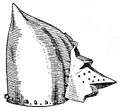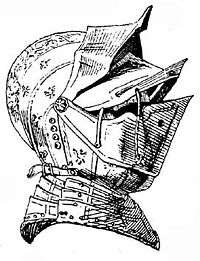Visor (armor)
A visor was used in conjunction with some Medieval war helmets such as the bascinet. The visor usually consisted of a hinged piece of steel that contained openings for breathing ("breaths") and vision. Visors protected the face during battle. Most knights or warriors who wore visors usually were spotted on horses during war, and more specifically in tournaments. The word beaver is sometimes used interchangeably with visor, as in Shakespeare's Hamlet, when Hamlet and Horatio are discussing the Ghost. Hamlet says: "Then saw you not his face?" to which Horatio responds "O yes, my lord. He wore his beaver up [i.e., his visor raised]".
 Early type of visor known as Klappvisier
Early type of visor known as Klappvisier- The prominent visor of a bascinet, c. 1400. Kunsthistorisches Museum, Vienna, Austria
 Double visor (first appeared for armets and close helms mat 20s of 16c)
Double visor (first appeared for armets and close helms mat 20s of 16c) Early Double Visored (Sallet transitional to close helm). The bevor and the forehead attached to the same pivot as the upper visor. Some version of this kind of sallet had additional nape protection under the tail.
Early Double Visored (Sallet transitional to close helm). The bevor and the forehead attached to the same pivot as the upper visor. Some version of this kind of sallet had additional nape protection under the tail.
This article is issued from Wikipedia. The text is licensed under Creative Commons - Attribution - Sharealike. Additional terms may apply for the media files.
